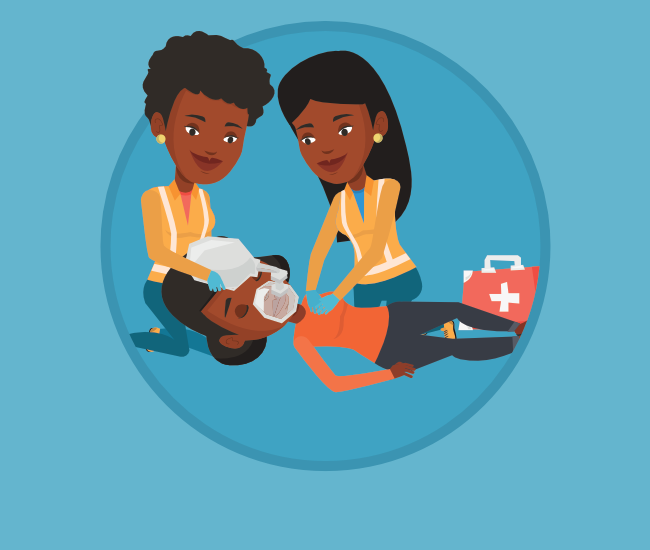Both men and women may experience cardiac events requiring CPR. However, research shows a gap when it comes to equitable performance of CPR on men versus women.
At the American Heart Association’s Scientific Session in November 2017, global researchers and clinicians shared data that showed men were more likely than women to receive life-saving CPR in public.1
In public settings, 45% of men received cardiac assistance compared to only 39% of women. Overall, men were 1.23 times more likely to receive bystander CPR in public settings, and their odds of survival were 23% better than women’s.
Let’s look at the reasons contributing to this disparity with the aim of helping more people perform CPR on women when needed.
Women’s heart attacks present differently than men’s
Women don’t always have the quintessential chest-grasping pressure that we see on TV or in movies, yet she may need CPR to help save her life.
The American Heart Association explains that women’s heart attack symptoms frequently differ than men’s and therefore tend to go without the proper medical attention needed. Some women may appear to have acid reflux or the flu, when in fact they are experiencing symptoms of heart troubles that could lead to an attack.2
WebMD adds that women may exhibit jaw pain, back pain, shortness of breath, nausea and vomiting along with chest pain while having a heart attack.3
These differences may make it easy for a woman’s heart attack to go undetected, thereby contributing to the lower rate of CPR administration on women versus men.
Proper CPR training and regularly reviewing the symptoms of heart attacks in women and men may help a bystander appropriately recognize when help is needed.
Fear of hurting a woman with CPR
Properly performing CPR frequently results in broken ribs or other injuries. The smaller build of many women compared to men may make a person afraid of hurting them when administering CPR.
The fact of the matter is that properly administering CPR on any person, regardless of gender or size, may result in bruising or even broken bones. CPR requires sufficient pressure on the chest in order to restart the heart. A good CPR training course should emphasize this point to help alleviate this concern.
Perception that women are less likely to have heart problems
The need to perform CPR on a woman could be missed “specifically a perception that women are less likely to have heart problems, or may be overdramatizing or “faking” an incident.”4
Yes, women do experience heart failure, heart attacks or other cardiac events just like men (even if their symptoms may differ). A woman’s expression of any issue should not deter action by allowing people to give in to stereotypes that women get overly emotional about things. A heart attack is a heart attack and requires prompt response. For a woman, CPR may save her life, just as it can for a man.
Lack of comfort in working near breasts
The presence of breasts may confuse a person or cause hesitation. Bystanders are generally only trained on male manikins without breasts.
The steps involved in performing CPR on women are exactly the same as on a man and when the time comes to act, people should focus on the steps, not the gender, to help them perform this life-saving skill properly.
This issue may represent an opportunity to the industry by making female manikins, allowing people to practice CPR on a body with breasts to provide more confidence in this.
Concerns about sexual harassment allegations
Many men may hesitate or avoid performing CPR on a woman in public for fear of being accused of sexual assault or inappropriate touching of the woman. The lens on sexual misconduct in today’s society may help women in many cases, but potentially find them unable to get help when a cardiac emergency occurs.
Calling 911 before administering CPR is always recommended and may help a male bystander by allowing the 911 operator to guide them through any steps. The call record also provides documentation of the situation and the steps taken by the bystander. If a witness is present, that person may also take video of the CPR administration.
Male or Female: CPR Matters
The steps to perform CPR on women are the same as for men, yet realities exist that may make it harder for a woman to get help than a man.
Knowing that a person’s chance of survival doubles or triples when CPR is administered, the importance of performing CPR for any person cannot be overstated.
Be sure to take a CPR class, and be prepared to rescue anyone.
1 2017 American Heart Association Focused Update on Adult Basic Life Support and Cardiopulmonary Resuscitation Quality: An Update to the American Heart Association Guidelines for Cardiopulmonary Resuscitation and Emergency Cardiovascular Care, published November 6, 2017, accessed December 7, 2020, https://www.ahajournals.org/doi/10.1161/CIR.0000000000000539
2 Heart Attack Symptoms in Women, American Heart Association, accessed December 7, 2020, https://www.heart.org/en/health-topics/heart-attack/warning-signs-of-a-heart-attack/heart-attack-symptoms-in-women
3 Women’s Heart Attacks Are Different Than Men’s, WebMD, accessed December 7, 2020, https://www.webmd.com/women/news/20160125/womens-heart-attacks-are-different-than-mens-experts-stress#1
4 Two novel studies explore why women receive less CPR from bystanders American Heart Association Meeting Report – Poster Presentations 198 and 196, Session: APS.01.09, published November 05, 2018, accessed December 7,2020, https://newsroom.heart.org/news/two-novel-studies-explore-why-women-receive-less-cpr-from-bystanders?preview=2757
